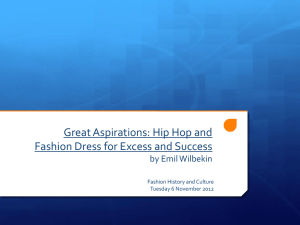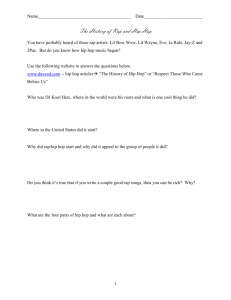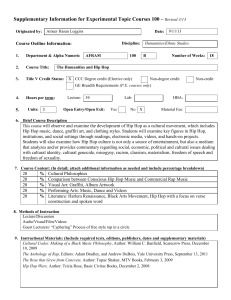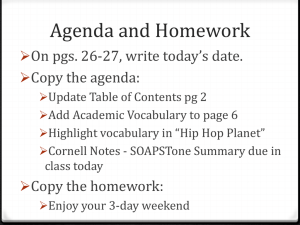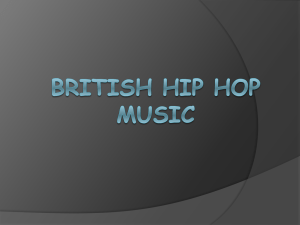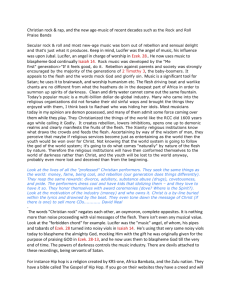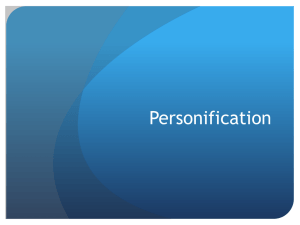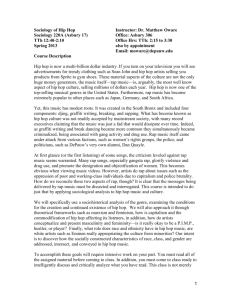View/Open - San Diego State University
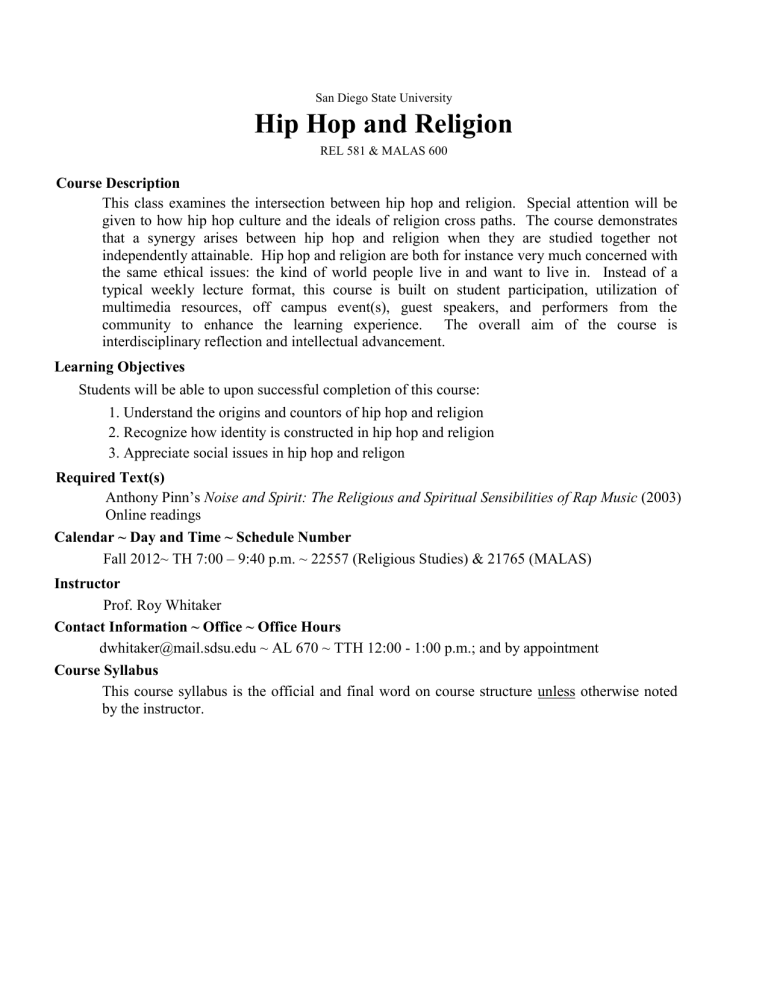
San Diego State University
Hip Hop and Religion
REL 581 & MALAS 600
Course Description
This class examines the intersection between hip hop and religion. Special attention will be given to how hip hop culture and the ideals of religion cross paths. The course demonstrates that a synergy arises between hip hop and religion when they are studied together not independently attainable. Hip hop and religion are both for instance very much concerned with the same ethical issues: the kind of world people live in and want to live in. Instead of a typical weekly lecture format, this course is built on student participation, utilization of multimedia resources, off campus event(s), guest speakers, and performers from the community to enhance the learning experience. The overall aim of the course is interdisciplinary reflection and intellectual advancement.
Learning Objectives
Students will be able to upon successful completion of this course:
1. Understand the origins and countors of hip hop and religion
2. Recognize how identity is constructed in hip hop and religion
3. Appreciate social issues in hip hop and religon
Required Text(s)
Anthony Pinn’s Noise and Spirit: The Religious and Spiritual Sensibilities of Rap Music (2003)
Online readings
Calendar ~ Day and Time ~ Schedule Number
Fall 2012~ TH 7:00 – 9:40 p.m. ~ 22557 (Religious Studies) & 21765 (MALAS)
Instructor
Prof. Roy Whitaker
Contact Information ~ Office ~ Office Hours
dwhitaker@mail.sdsu.edu
~ AL 670 ~ TTH 12:00 - 1:00 p.m.; and by appointment
Course Syllabus
This course syllabus is the official and final word on course structure unless otherwise noted by the instructor.
Assignments, Due Dates, and Points
ASSIGNMENTS
Quiz #1
Quiz #2
Participation
Weekly Response Papers
Midterm Paper
Final Paper
Final Exam
Total
DUE
N/A
N/A
N/A
N/A
October 11 th
November 29 th
December 13 th
POINTS
25
25
100
200
200
250
200
1,000
Final Grade Point Tally
The point system used below constitutes the student’s final grade when added together.
1,000-950 A 769-740 C
949-900 A- 739-700 C-
899-870 B+ 699-670 D+
869-840 B 669-640 D
839-800 B- 639-600 D-
799-770 C+ 599 or < F
2
Quizzes
There will be two unannounced quizzes based on the classroom content (e.g., lectures, activities, discussions, and assigned reading). Bring at least one parscore to each class. The red thin ones (e.g., Form No. F-289-PAR-L).
Final Exam
There will be one in-class blue book exam at the end of the semester.
Weekly Response Papers
Students will write for each class (except weeks 1, 14, 15, and 16) a weekly response paper based on the assigned readings. These are not research papers or reports on issues : rather than doing a lot of outside reading, you should focus on one or two of the readings for that week.
The idea is to critically engage the author’s claim(s), arguments, theories, concepts, assumptions, distinctions, etc. The recommended length is a paragraph or approximately 150 words. The weekly response papers must be typed, double-spaced, in a standard 12-point font
(e.g., Times ) with one-inch margins at the top and bottom of each page and 1.25-inch margins on either side (the default settings in Microsoft Word).
Research Papers
For this course students will write two research papers. The topics are of the student’s choosing, but it must be related to the class. The recommended page length for the midterm paper is 8-10 pages for undergraduates and 12-15 pages for graduate students. The
Cheating
Cheating is a violation of the norms of academic work. When you cheat you step outside of the boundaries of what is acceptable if we are to have integrity and honesty in intellectual pursuits.
You are in effect signaling a lack of desire to participate in the activities that mark your pursuit as an academic one. So what you do simply does not count as academic work when you cheat and so will be treated accordingly. An automatic “F” will be given if cheating is discovered and further policies as stated in the student handbook will be pursued. recommended page length for the final paper is 10-12 pages for undergraduates and 15-20 pages for graduate students. A minimum of three sources needed for each paper not including the book for the course. These papers must be typed, double-spaced, in a standard 12-point font (e.g., Times ) with one-inch margins at the top and bottom of each page and 1.25-inch margins on either side (the default settings in Microsoft Word).
3
Plagiarism
Plagiarism is a form of cheating. It is the unattributed use of someone else’s work. One of the most common forms of plagiarism occurs when you cut and paste pieces of information that you find on the web. This is unacceptable if you do not attribute the source and even if you attribute the source it is unacceptable if this is the primary way in which you have written your work. A student’s work may be submitted for a plagiarism check using available means.
Plagiarized work will not only receive zero points – i.e. an “F” – but the instructor has the option of further academic sanctions, including but not limited to failure of the course. If you are not sure whether or not you may be plagiarizing check with the instructor. The following websites are also useful in clarifying what plagiarism is and how you can avoid it: http://owl.english.purdue.edu/handouts/research/r_plagiar.html http://www.indiana.edu/~wts/pamphlets/plagiarism.shtml
Late Work
All course assignments should be submitted on time. If course assignments (e.g., weekly response papers, midterm paper, and final exam) are submitted after the date due, then it will earn a 20% deduction of the original grade. These assignments, if late, are to be turned in at the final exam to receive credit. Nothing is accepted after the final exam of the class.
Absences
Attending each class is expected and is vital for doing well in this course. Poor attendance will negatively affect grades and an inability to complete assignments as well as could have been.
If you fail to participate in class activities this will be considered a sufficient indicator that you are not able to satisfactorily complete the course. Even if absent, assignments are still due on the date and time due and to be submitted in hardcopy form to the instructor.
Students with Disabilities
If you have a documented disability requiring accommodation for this class, please contact the appropriate office and notify the instructor.
Classroom Learning Environment
Classroom learning environment must be free from disturbances, such as side-conversations, tardiness, cell phones ringing, reading newspapers, eating food in class, bringing others to class, making derogatory racial/ethnic remarks, falling asleep, interrupting others, being hostile or antagonistic, recording devices used during class, sending mass emails to the class, etc.
4
Use of Cell Phones/Communication Devices
Here is the warning: there is absolutely no use of cell phones/communication devices in class.
No text messaging and checking messages are allowed during class time. This is considered talking on the phone. If students do this they will be asked to leave class the first time . If this is done again, then other negative measures will be applied – e.g. student not allowed to come to class, grade lowered in the class at the discretion of the instructor. In other words, don’t do it.
Use of Laptops
If students would like to use a computer in class for note taking, then they need to sit up front in the class to do so. And of course no web surfing, checking Facebook, playing solitaire, shopping online, etc. Such activities will not only cause one to lose participation points, but other consequences like the inability to use the computer in class at all.
Participation
The development of oral skills is given a high priority in this course. The classroom should be considered a laboratory in which a student can test their ability to convince their peers of the correctness of their approach. The quality of such participation is as important as the quantity.
For example, it’s fine to say “I agree” to a position, however that does not constitute participation since it does not add anything of substance to the discussion at hand. Substantive participation is adding new ideas, perspectives, pointed follow-up questions, etc. to the learning environment. Substantive participation is very much encouraged, yet not at the price of drowning-out other voices in the classroom. That is, respect for other views will be sought at all cost. Respect is the foundation for successful teaching and learning. Substantive participation is a required part of the students’ grade and is not the same as attendance.
Generally speaking, participation translates into five district types of categories:
Outstanding Contributor: Contributions in class reflect thorough preparation. Ideas offered are usually substantive, provide one or more major insights, as well as, direction for the class.
Arguments, when offered, are well substantiated and persuasively presented. If this person were not a member of the class, the quality of the discussions would be diminished significantly.
Good Contributor: Contributions in class reflect thorough preparation. Ideas offered are usually substantive, provide good insights and sometimes direction for the class discussion.
Arguments are generally well substantiated and are often persuasive. If this person were not a member of the class, the quality of the discussion would be diminished considerably.
5
Adequate Contributor: Contributions in class reflect satisfactory preparation. Ideas offered are sometimes substantive, provide generally useful insights, but seldom offer a major new direction for the discussion. Arguments are sometimes presented and are fairly well substantiated and sometimes persuasive. If this person were not a member of the class, the quality of the discussions would be diminished somewhat.
Non-participant: This person has said little or nothing in class. Hence, there is no adequate basis for evaluation. If this person were not a member of the class, the quality of the discussions would not be changed.
Unsatisfactory Contributor: Contribution in class reflects inadequate or non-existent preparation. Ideas offered are seldom substantive; provide few, if any, insights; and rarely provide a constructive direction for the class discussion. Integrative comments and effective arguments are completely absent. Class contributions are, at best, “time fillers” efforts to make isolated, obvious, or confusing points. If this person were not a member of the class, valuable class time would be saved.
Written Grading Criteria
Content/Development (e.g., clear, substantive thesis; details/examples; research; sustains insight; in-depth analysis of complex ideas; higher order thinking; etc.).
Organization/Format (e.g., MLA; introduction with logical flow of body and conclusion; complete, well-structured sentences; transitions; grammar/punctuation/spelling; word choice and tone; reference page; etc.).
6
Ratings and Standards of Papers
Rating
A = Excellent
B = Good
C = Fair
D = Poor
F = Unacceptable
Standards
· Excellent Performance
· Focused, Succinct Thesis/Topic
· Organized from Beginning to End to Support Thesis/Topic
· Effective, Germane Use of Textual Support
· Originality of Ideas
· Firm Grasp of Content
· Varied Sentence Structure
·
Correct Mechanics and Paragraphing
· Effective Word Choice
· Fluid Transitions
·
· Sustains Insight, In-Depth Analysis of Complex Ideas
Develops Clear and Supports Main Points with Logically Compelling
Reasons and/or Highly Persuasive Examples
· Etc.
· Above Average Performance
· Focused, Succinct Thesis/Topic
·
Adequately Organized to Support Thesis/Topic
·
· Some Originality of Ideas
· Solid Grasp of Content, Minor Confusions
· Textual Support not Always Effective, Germane
Mechanical Problems that Don’t Interfere with Readability
· Clear, Well-Formulated Sentences and Correct Mechanics and Paragraphing
· Lacks Depth in Thinking or Creative Ideas
· Shows Understanding, Knowledge, But Doesn’t Go Any Further than
Informational
· No Extra Ideas of Opinions
· Not as In-Depth as Excellent Performance, But Still Fully Answers Question
· Etc.
· Average Performance
· Unfocused, Weak Thesis/Topic
·
Partially Organized to Support Thesis/Topic
· Paucity of Original Ideas
· Some Grasp of Content, Significant Confusions
· Ineffective Textual Support
· Incomplete, Poorly Formulated Sentences
· Careless Editing/Informal, Inappropriate Language
· Mechanical Errors that do Interfere with Readability
· Etc.
·
· Demonstrates Understanding at the Most Rudimentary Level
No Thesis/Topic
· Lack of Organization
· Underdevelopment of Ideas/No Original Ideas
· Little Grasp of Content, Major Confusions
· Little Textual Support, Irrelevant Appeal to Text
· Lack of Editing /Mechanical Errors that Interfere with Readability
· Etc.
· No Topic/Thesis
· Inappropriateness
· Unintelligibility/No Grasp of Content
· No Organization/Structure
· Etc.
7
Course Readings
Week of the Semester
Week 1
Week 2
Week 3
Week 4
Week 5
Week 6
Week 7
Welcome to the Course!
(August 30 st )
Origins and Contours of Hip Hop and Religion
Noise and Spirit
Anthony Pinn: “Introduction: Making a World with a Beat: Musical
Expression’s Relationship to Religious Identity and Experience”
Mark Taylor: “Bringing Noise, Conjuring Spirit: Rap as Spiritual Practice”
Online Reading #1
(September 6 th )
Hip Hop, Reggae, and Rastafarianism
Noel Leo Erskine: “Rap, Reggae, and Religion: Sounds of Cultural
Dissonance”
Online Reading #2
(September 16 th )
Hip Hop, Gender, and Religion
Noise and Spirit
Leola Johnson: “The Spirit is Willing and So Is the Flesh: The Queen in
Hip-Hop Culture”
Online Reading #3
(September 20 th )
Hip Hop, Buddhism, and Death
Noise and Spirit
James Perkinson: “Rap as Wrap and Rapture: North American Popular
Culture and the Denial of Death”
Online Reading #4
(September 27 th )
Hip Hop and Islam
Noise and Spirit
Juan M. Floyd-Thomas: “A Jihad of Words: The Evolution of African
American Islam and Contemporary Hip-Hop”
Online Reading #5
(October 4 th )
Hip Hop and Christianity
Noise and Spirit
Garth Kasimu Baker-Fletcher: “African American Christian Rap:
Facing ‘Truth’ and Resisting It”
Online Reading #6
Midterm Paper Due
(October 11 th )
8
Week 12
Week 13
Week 14
Week 15
Week 16
Week 17
Week 17
Week 18
Week 8
Week 9
Week10
Week 11
Field Trip #1 (Magic 92.5 Radio Station)
Online Reading #7
(October 18 th )
Jay-Z, Religion, and Philosophy
Online Reading #8
(October 25 th )
Field Trip #2 (Access Music)
(November 1 st )
Hip Hop and Humanism
Noise and Spirit
Anthony Pinn: “Handlin’ My Business’: Exploring Rap’s Humanist
Sensibilities”
Online Reading #9
(November 8 th )
Tupac and Religion
Ralph Watkins: “Rap, Religion, and New Realities: The Emergence of a
Religious Discourse in Rap Music”
Online Reading #10
(November 15 th )
November 22 Holiday – Thanksgiving Recess
(November 22 nd )
Hip Hop and Religion @ the Movies
Final Paper Due
(November 29 th )
Hip Hop and Morality
Noise and Spirit
William Banfield: “The Rub: Markets, Morals, and the ‘Theologizing’ of Music”
(December 6 th )
Final Exam
(December 13 th ~ 7 p.m.)
N/A
(December 20 th )
N/A
(December 27 th )
Grades Submitted
(December 31 th )
9
10

